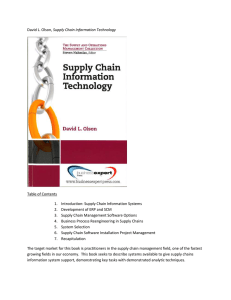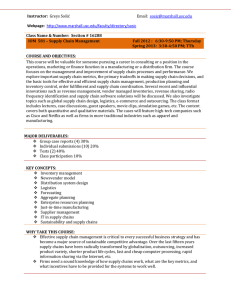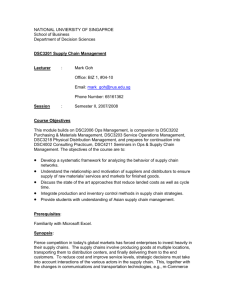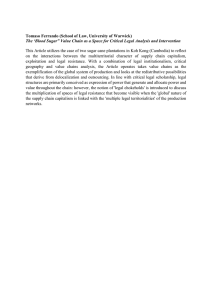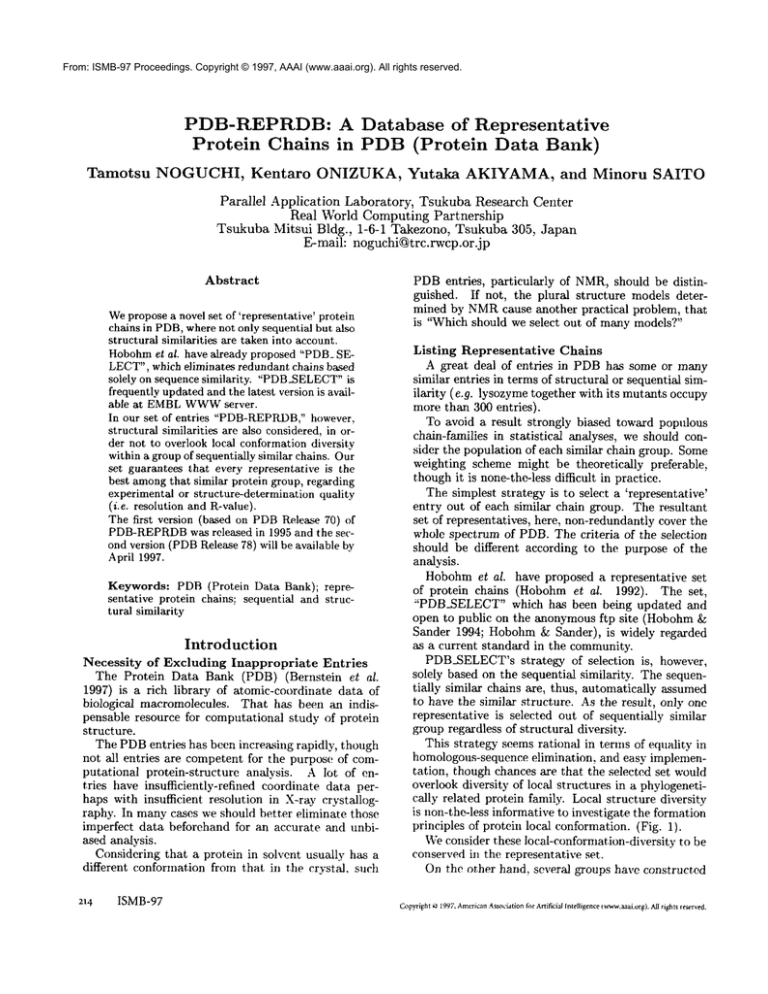
From: ISMB-97 Proceedings. Copyright © 1997, AAAI (www.aaai.org). All rights reserved.
PDB-REPRDB: A Database
of Representative
Protein
Chains in PDB (Protein
Data Bank)
Tamotsu NOGUCHI,Kentaro
ONIZUKA, Yutaka AKIYAMA,and Minoru SAITO
Parallel
Application Laboratory, Tsukuba Research Center
Real World Computing Partnership
Tsukuba Mitsui Bldg., 1-6-1 Takezono, Tsukuba 305, Japan
E-maih noguchi@trc.rwcp.or.jp
Abstract
Weproposea novel set of ’representative’ protein
chains in PDB,wherenot only sequential but also
structural similarities are taken into account.
Hobohmet al. have already proposed "PDB_SELECT",which eliminates redundant chains based
solely on sequence similarity. "PDB_SELECT"
is
frequently updatedand the latest version is available at EMBLWWW
server.
In our set of entries "PDB-I~EPRDB,"
however,
structural similarities are also considered,in order not to overlook local conformationdiversity
within a groupof sequentially similar chains. Our
set guarantees that every representative is the
best amongthat similar protein group, regarding
experimental or structure-determination quality
(i.e. resolution and R-value).
The first version (based on PDBRelease 70)
PDB-REPRDB
was released in 1995 and the second version (PDBRelease 78) will be available
April 1997.
Keywords: PDB(Protein Data Bank); representative protein chains; sequential and structural similarity
Introduction
Necessity of Excluding Inappropriate Entries
The Protein Data Bank (PDB) (Bemstein et al.
1997) is a rich library of atomic-coordinate data of
biological macromolecules. That has been an india
pensable resource for computational study of protein
structure.
The PDBentries has been increasing rapidly, though
not all entries are competent for the purpose of computational protein-structure
analysis. A lot of entries have insufficiently-refined
coordinate data perhaps with insufficient resolution in X-ray crystallography. In manycases we should better eliminate those
imperfect data beforehand for an accurate and unbiased analysis.
Considcring that a protein in solvent usually has a
different conformation from that. in tile crystal, such
214
ISMB-97
PDBentries, particularly of NMR,should be distinguished. If not, the plural structure models determined by NMRcause another practical problem, that
is "Which should we select out of manymodels?"
Listing Representative Chains
A great deal of entries in PDB has some or many
similar entries in terms of structural or sequential similarity (e.g. lysozymetogether with its mutants occupy
more than 300 entries).
To avoid a result strongly biased toward populous
chain-families in statistical analyses, we should consider the population of each similar chain group. Some
weighting scheme might be theoretically preferable,
thoughit is none-the-less difficult in practice.
The simplest strategy is to select a ’representative’
entry out of eaeh similar chain group. The resultant
set of representati~es, here, non-redundantly cover the
whole spectrum of PDB.The criteria of the selection
should be different according to the purpose of the
analysis.
ttobohm et al. have proposed a representative set
of protein chains (Hobohm et al. 1992). The set,
"PDB_SELECT"which has been being updated and
open to public on the anonymous ftp site (Hobohm
Sander 1994; Hobohm& Sander), is widely regarded
as a current standard in the community.
PDB_SELECT’s
strategy of selection is, however,
solely based on the sequential similarity. The sequentially similar chains axe, thus, automatically assumed
to have the similar structure. As the result, only one
representative is selected out of sequentially similar
group regardless of structural diversity.
This strategy seems rational in terms of equality in
homologous-sequence elimination, and easy implementation, though chances are that the selected set would
overlook diversity of local structures in a phylogenetically related protein family. Local structure diversity
is non-the-less informative to investigate the formation
principles of protein local conformation. (Fig. 1).
Weconsider these local-conformation-diversity to be
conserved in the representative set.
On the other hand, several groups have constructed
C~yright~9~7~Am~rican.~.ss~dati~nfc~rArti~ci;.d[nt~ig~nc~www.aaai.~rgkA~[rghsr~s~rv~d
’ i.i:."::.":"::i."".ii.i..:.::::
¯ ....: ............
m
¯ . . . .
¯ .....
.....
¯ . . .
..
.::
..
.
...
.....
... :
. ....
¯... .
.........
¯ ....
. ..
..........
m
m
¯":-"" ""
.......:.:.....~
....:............
:.....:.
Figure 1: Example of local conformation disagreements: In this case, a query sequence, Lactate Dehydrogenase
(8LDH), is superimposed to three related chains. The sequence of 1LDMis 100%identical to 8LDH,while a turn
structure (residues 101-106) shownin the upper-right region disagrees with that part of 8LDH,due to the different
complex formation. The other two (2LDXand 1LLD)with less sequence identity better fit to 8LDH.
useful databases: e.g. CATHproposed by Orengo et
al. and SCOPby Murzin et al. These classified the
protein chains regarding both sequential and structural
similarity.
CATHand SCOPare available
on WWW
sites (Orengo eta/.; Murzin eta/. 1995) and enthusiastically utilized by structure biologists in the world.
What they did is, however, actually hierarchical classification of protein chains. They did not selected representatives for the purposes of statistically unbiased
structure analysis.
PDB-REPRDB: A new representative
chain
database
In this paper, we report our "PDB-REPRDB,"a
new database of representative protein chains selected
from PDB.The criteria of selecting the representatives
are, a) quality of atomic coordinate data, b) sequence
uniqueness, and c) conformation uniqueness particulaxly local.
The first version of PDB-REPRDB
consists of 763
representative
chains from PDB Release 70 (Oct.
1994) and was released in July 1995 on GenomeNet
WWW
server (Noguchi 1995). Each entry has hyperlinks to that entry in PDB.
The new version of PDB-REPRDBselected from
PDBRelease 78 (Oct. 1996) will be scheduled to
released (Noguchiet al.). The selection policy remains
the same, while the selection procedure is almost completely automated by sophisticated algorithms. The
system parailelization
ture work.
is one thing yet to do as a fu-
Methods
The new version of PDB-REPRDBis derived from
PDBRelease 78 (Oct. 1996). The procedure of selecting representative protein chain is as follows.
Phase 1: Excluding inappropriate
entries
Those PDBentries which matches any of the conditions below are excluded in this phase.
a) DNAand RNAentries,
b) data derived by NMRspectroscopy,
c) theoretically
modeled data,
d) short chains (l < 40 residues),
e) data without backbone coordinates at all residues,
f) data without side chain coordinates at all residues,
or
g) data without refinement (by X-PLOR,TNT, etc.).
The current scope of our database is concentrated on
those protein structures determined by Xoray crystallography. Hence, those entries of (a) DNAand RNA,
or determined by (b) NMR,or (c) theoretical modeling
are excluded.
Noguchi
2~5
Phase 2: Sorting chains with respect
to
data quality
All chains are extracted from each entry selected
through phase 1. These chains are subject to the selection in phase 2. This phase actually sort tim chains
according to the data quality.
First, the selected chains are classified into two
classes. Class A chains are those with good resolution
(<__ 3.0 A) and good R-Factor (<_ 0.3). Other chains
are classified into class B.
Second, we sort the chains with respect to the resolution of structure determination within each class (A
and B). The chains with the same resolution are further
sorted by R-Factor value. Whenplural chains have tile
same resolution and R-Factor, those are sorted by:
1. the numberof chain breaks (the less the better),
2. the number of non-standard amino acid residues (the
less the better),
3. the number of residues without backbone coordinates (the less the better),
4. the number of residues without side chain coordinates (the less the better),
5. whether mutant or wild (the wild type has priority),
6. whether complex or not (the non-complex has priority), and
7. alphabetical order of the entry name.
(e.g.
1MCD< 1MCE, 5AT1A < 5AT1C)
Phase 3: Elimination
of the redundant
chains
In this elimination phase, those chains with better
quality have the priority to be the representatives. The
first chain in the sorted list is to be the first representative because the chain has the best quality. The
algorithm to determine all representatives is simple.
Suppose we have already selected N representatives
from the sorted list. Nowthat the sorted list does not
contain the chains 1) which have already been selected
and taken out as the representatives, 2) which have already been eliminated through the selection procedure
of the N representatives.
Thus, the first chain remained in the sorted list has
the highest priority to be the next representative. We
check the "similarity" between the first chain of the
list and each of the already selected representatives.
If the first chain is not similar to any of the selected
representatives, the first chain becomesthe (N + 1)-st
representative. If the first chain is similar to at least
one of the representatives, the chain is eliminated, and
then, the second chain comesto the first of the sorted
list. This procedure repeats until the sorted list goes
to null.
The representatives are firstly selected from class A
chains. Class B chains are also sorted and appended
216
ISMB-97
Table 1:
Comparison
of PDB-REPRDB and
PDB_SELECTbased on PDB Release 78
Numberof chains
PDB-REPRDB PDB_SELECT
ver.2.0 (1997)
(1997)
1089
1405
Total
X-Ray Data
1089
1184
0
214
NMRData
7
Other Data
0
Note: Threshold sequence identity (ID%)here is 75%.
Table 2: Threshold sequence identity
ber of selected chains
(ID%) and num-
Numberof chains
Threshold
sequenceidentity
PDB-REPRDB PDB~SELECT
(1997)
(ID%)
ver.2.0 (1997)
1405
75
1089
1139
8O
1546
85
1251
9O
95
1718
Note: Both databases are based on PDBRelease 78.
to the tail of the list, thus these chains are chosenonly
if there are no similar chain available in class A.
In the similarity check, we consider the sequence is
NOTsimilar,
¯ if the sequential identity is less than a certain threshold value (_< 90%, 80%, 75%, etc.), where the sequence identity is measured by FASTAalgorithm
(Pearson & Lipman 1988; Pearson 1990),
¯ or, if the maximumdistance between the superimposed pair of atoms each from the two structures
that we are looking at is greater t han a certain
threshold (>_ 10 .~ in this paper, 9 A , etc.).
Before superimposing the two structures, we align
the two sequences by the pairwise sequence alignment.
The matched sites in the alignment axe superimposed
by the least square fitting procedure (Kabsch 1976;
Kabsch 1978).
Finally, all the chains (both in (:lass A and B)
classified into protein-chain groups, where each chain
is classified into the group whoserepresentative chain
is sequentially nearest to the chain.
Comparison
with
PDB_SELECT
To clarify the difference between our representative
chain set and PDB_SELECT(Hobohm et al. 1992;
Hobohm & Sander 1994; Hobohm & Sander),
we
compared the number of selected chains of ours and
PDB_SELECT
as shown in Table 1. Both representative sets are based on PDBrelease 78.
When the threshold sequence-identity
(ID%) for
defining a sequentially similar group is 75%, the number of representative
chains is 1080 in our PDBREPRDBwhere the structures
determined by NMR
and MODEL
were eliminated.
The number of chains
in PDB_SELECT
is 1405 in total, and 1184 for X-ray
but it includes manylow quality data.
Table 2 shows the number of selected chains varied
with the threshold value for ID%.
Discussion
The first version of PDB-REPRDB
already had such
chains that are sequentially similar to other chains but
have different local structure. The second version has
even more chains in this respect.
Considering the increasing structures determined by
NMRspectroscopy in PDB, it is not a good strategy
to ever eliminate those NMRstructures from the representative set. Since our representative set considers structural similarity, it is required to establish a
method to compute the similarity between structures
by X-Ray diffraction
and NMR.Then we will have
greater number of structurally similar groups than the
current dataset.
In addition, we need even more automated selection
method of representative chains from the large number
of entries in PDB.Weare going to implement a fully
parallelized system which assures a quick selection of
representative chains on user’s demand, or as soon as
the new version of PDBis released.
Conclusion
In this paper, we proposed PDB-REPRDB
(a novel
’representative’ database of protein-chains f~om PDB),
whose selective criterion is based on sequential and
structural difference.
It was first for our own research activities (i.e.
protein secondary structure prediction, local structure classification) that we developed the first version of PDB-REPRDB.We knew, then, that the selected dataset was strongly recommendableto the researchers of protein-structure fields. The point is that
our dataset discriminates sequentially similar chains
with meaningful local structure diversity (due to insertions, deletions, or mutations), and even discriminates
small structural change caused by complex formation.
The new version about to be released will contribute
toward improvements of the quality of protein structure analyses. We hope that our PDB-REPRDB
will
be used as widely as other pioneering database system
like PDB_SELECT, SCOP and CATH.
Acknowledgments
We thank Dr. Susumu Goto and Prof. Minoru Kanehisa at Institute for Chemical Research, Kyoto University for useful discussions and suggestions.
References
Bernstein, F. C.; Koetzle, T. F.; Williams, G. J. B.;
Meyer, E. F., Jr.; Brice, M. D.; Rodgers, J. R.; Kennard, O.; Shimanouchi, T.; and Tasumi, M. 1977. The
Protein Data Bank: A Computer-based Archival File
for Macromolecular Structures. Journal of Molecular
Biology 112: 535-542. http://www.pdb.bnl.gov/
Hobohm,U.; Scharf, M.; Schneider, R.; and Sander,
C. 1992. Selection of a representative set of structures
from the BrookhavenProtein Data Bank. Protein Science 1: 409-417.
Hobohm,U.; and Sander, C. 1994.
Enlarged representative set of protein structures. Protein Science 3: 522.
Hobohm, U.;and Sander, C. PDB_SELECT: Representative list of PDBchain identifiers.
http://www.sander.embl-heidelberg.de/pdbsel/
explanation.html
Orengo, C. A.; Michie, A. D.; Jones, S.; Swindells, M.
B.; Jones, D. T.; and Thornton, J. M.
CATH:Protein Structure Classification, version 1.0.
http://www, biochem, ucl. ac. uk/bsm/cath
Murzin, A. G.; Brenner, S. E.; Hubbard, T.; Chothia,
C. 1995. scop: a structural classification of proteins
database for the investigation of sequences and structures. Journal of Molecular Biology 247: 536-540.
http://scop.
mrc-lmb,
cam.ac.uk/scop/
Noguchi, T. 1995. PDB-REPRDB
ver.l.0 served on
GenomeNet WWW
Server.
http: //w-w¢. genome, ad. j p/htbin/show_pdbreprdb
Noguchi, T.; Onizuka, K.; Akiyama, Y.; and Saito,
M. 1997. PDB-REPRDBver.2.0
served on RWCP
WWW
Server. http://~w .rwcp. or. jp/lab/mpap/
Pearson, W. R.; Lipman, D. J. 1988. Improved Tools
for Biological Sequence Analysis. Proc. Natl. Acad.
Sci. 85: 2444-2448.
Pearson, W. R. 1990. Rapid and Sensitive Sequence
Comparison with FASTP and FASTA. Methods in
Enzymology 183: 63-98.
Kabsch, W. 1976. A solution for the best rotation to
relate two sets of vectors. Acta Cryst. A32: 922-923.
Kabsch, W. 1978. A discussion of the solution for the
best rotation to relate two sets of vectors. Acta Cryst.
A34: 827-828.
Noguchi
217

